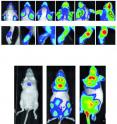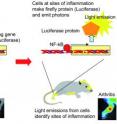Stopping autoimmunity before it strikes
Current research describes a new method to track the development of autoimmune diseases before the onset of symptoms. The related report by Zangani et al, "Tracking early autoimmune disease by bioluminescent imaging of NF-κB activation reveals pathology in multiple organ systems," appears in the April 2009 issue of The American Journal of Pathology. Autoimmune diseases such as lupus, multiple sclerosis, rheumatoid arthritis and diabetes are caused when the immune system attacks the body's own cells. Normally, immune cells are prevented from attacking normal cells; however, in patients with autoimmune disease, this "tolerance" is lost. The immediate causes of autoimmune diseases remain unknown, partially due to the inability to detect disease before the onset of symptoms. Early detection of autoimmune disease is critical for assessing new treatments.
The molecule NF-κB is activated by inflammation, which plays a key role in autoimmune disease development, making NF-κB a prime candidate to track autoimmune activity. Researchers at the University of Oslo led by Drs. Ludvig Munthe and Bjarne Bogen in collaboration with Rune Blomhoff engineered NF-κB such that it would emit light when activated. Using a mouse model of systemic autoimmunity with features of lupus, they found that NF-κB activation signals were present in affected organs several weeks before the clinical manifestations of disease. The light signal intensity correlated with disease progression. NF-κB tracking may therefore provide a new tool in the evaluation of early autoimmune therapies.
The article from Zangani et al "indicate[s] that NF-κB mediated bioluminescence is a very sensitive and early indicator of inflammation and disease", allowing precise identification of incipient disease sites for biomedical and pathogenetic studies. In future studies, Drs. Munthe, Bogen, and colleagues will utilize this new model "for studies on early intervention, e.g. drug treatment, to prevent or treat autoimmune disease", and for studies of the development of B cell lymphoma.
Source: American Journal of Pathology
Other sources
- Stopping autoimmunity before it strikesfrom Biology News NetThu, 26 Mar 2009, 0:49:09 UTC

